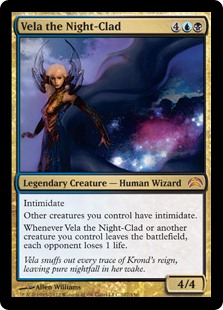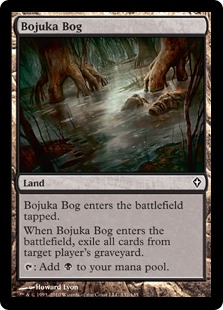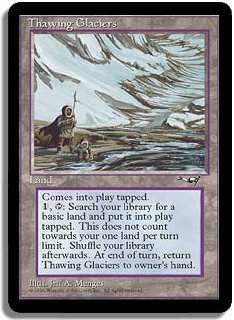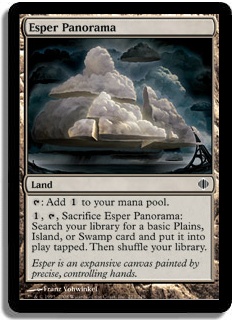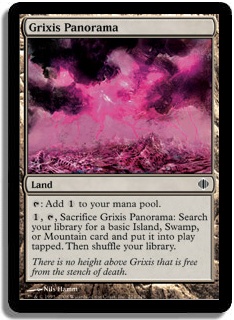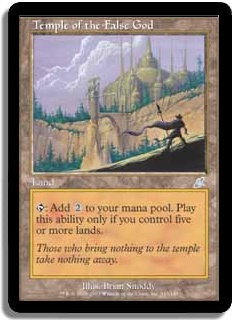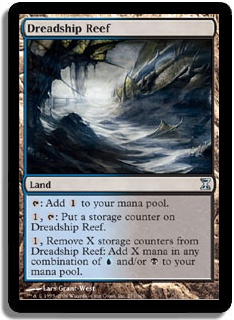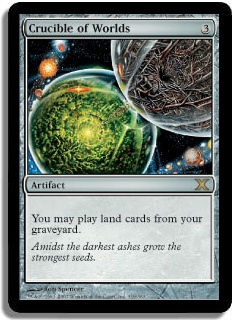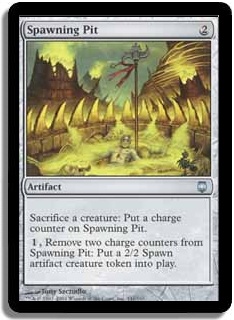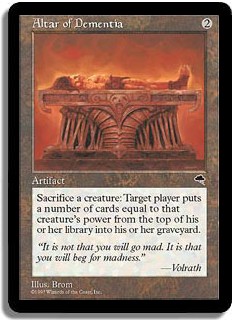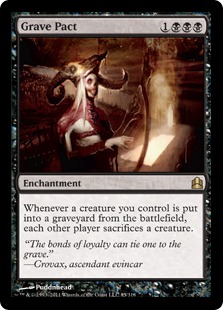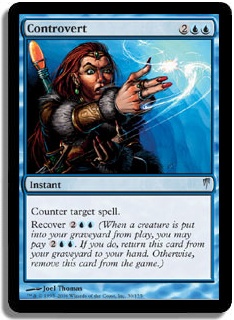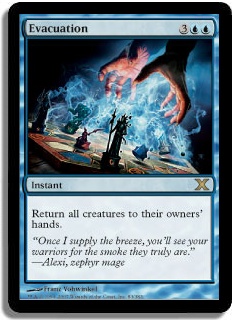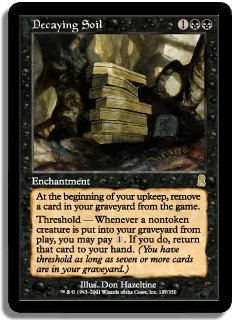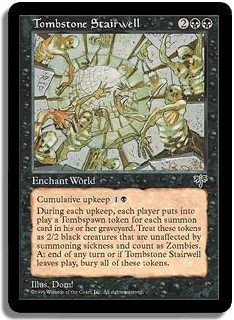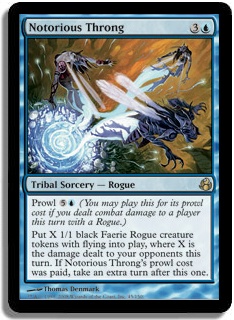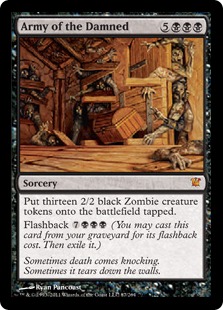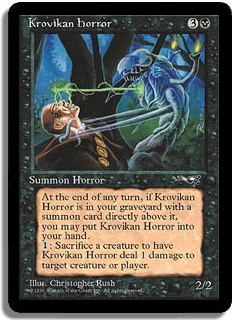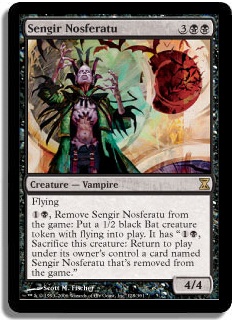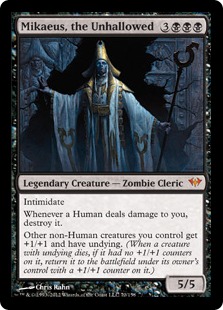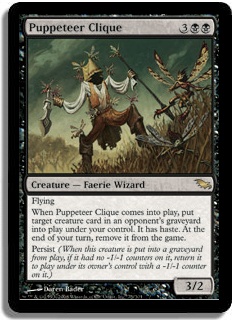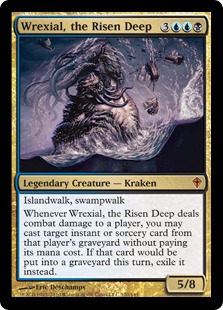I suppose you could say Cassidy got lucky—I’ve been wanting to build new decks around the new Planechase commanders, and by chance or happenstance he got to cover Thromok the Insatiable last week because he got to the shared ‘dearazami’ email box first. Without a second Planechase commander submission emailed in, I started working on new submissions I found interesting, then realized what I really wanted to do was talk about Vela the Night-Clad. So that’s what I’m going to do.
I’ve been in a bit of a funk lately when it comes to Commander. Animar stopped being fun because the new cascade cards in Planechase really just push it to a new level of ridiculousness, new concept decks I’d been working on were proving to be less fertile fields of imagination than I’d thought they would be, and I took every Commander deck I owned save for my time-worn Godo, Bandit Warlord deck apart. Godo got to stick around because a good red deck is hard to find, and he’s in that sweet spot of effective and durable that I really liked pursuing. It’s that sweet spot I’m going to be pursuing with Vela today.
Vela has some interesting ramifications we can play into. Token creation is going to be powerful because Vela cares about creatures, not cards, so we can pursue that angle and find it worthwhile to mine. The life-drain ability is not limited to creatures dying and mass-bounce effects are going to do just fine, so in addition to the stuff like Living Death that is obviously just really good in Commander, Evacuation effects are also going to be very potent. You can even do goofy stuff and have it work out, like the multiple-ninjutsu trick to bounce more than one creature with the same one Ninja card, and that is a trick I have always wanted to see do something… How weird is it to see ‘ninjutsu uses the stack’ being relevant to a game?
Putting a new deck together is an interesting way to analyze my personal level of power creep. Part of the reason I had to put Animar down is because I kept honing that knife, and it got sharper and sharper to the point where it was ridiculously consistent at finishing a game of Commander long before most would even consider it as having begun. Scrimmaging as hard as you can is fine, in a certain context, but jamming as hard as possible to be as nasty as possible is not actually most peoples’ definitions of fun—and it is that reason exactly that Griselbrand is now Grisel-banned, because we’re supposed to be having a certain basic amount of fun in these games or why are we playing them?
With that in mind, I reached for the kid gloves again and was happy to do so; sure, you could try to build an infinite mana combo engine whereby obscure cards combined to kill a table in one fell swoop, something along the lines of Shield Sphere + Ashnod’s Altar + Decaying Soil to achieve both infinite mana and, with Vela, infinite damage while we’re at it. These things are not fun, and as a central axiom of this column (and this format), these are not things you will ever see me do. In researching some of these possibilities, however, new interesting cards to explore come to mind—I don’t want the combo elements, but I do find Decaying Soil interesting enough to pursue, especially since this deck is going to try and be pretty happy-go-lucky in the ‘sacrificing things for fun and profit’ stage of the game. Recursion makes me happy, after all, as does playing cards people have literally never seen in their life before or cards otherwise dismissed as ‘best used as a bookmark or coaster.’
Begin At The Beginning
Mana bases are not the sexy, flashy part of a deck… but they matter. Too few lands or the wrong color balance really messes things up, and there are interlocking dependencies based on the other cards you put in your deck. In this case, I know I’m going to borrow a few of my other favorite tricks (I am basically a Crucible of Worlds addict when it comes to Commander, though only for basically fair usages) and since this deck will end up having a token theme, Skullclamp is the obvious inclusion. Trinket Mage for Skullclamp is going to be part of the deck, so being able to use the Mage to find black mana will be worthwhile. Since there’s a lot of black mana and not a lot of blue, however, that means Vault of Whispers but no Seat of the Synod. The deck wants basics in reasonable quantity, and there is a significant drawback to having a second (see also: vulnerable) card type on your lands.
Yes, there is obviously a Winding Canyons in this deck. However, no Dust Bowl—switching it up for the user in the forums who insisted it was getting pretty darn boring that there were clearly two automatic inclusions, as if Commander wasn’t a format that had its fair share of staples.
Balancing lands that come into play tapped versus ones that don’t is always interesting. I’ve built Commander decks with as many as fifteen lands that start play tapped and not considered it a major disadvantage, since it had plenty of ‘skipped’ slots on the mana curve…twos but not threes, fours but not fives, biased enough (and almost entirely by accident) that suddenly there was no real downside to playing this way because on turn 3 I’d still play a spell and a land and ditto for turn 5.
This deck is unfortunately not going to have that advantage, since the token producers in these two colors are fairly spread out across the mana curve. Knowing I’m going to want to hit my twos through sixes makes this harder, so suddenly I can’t include easy free lands like Jwar Isle Refuge and its Invasion and Coldsnap cousins, having to actually worry about making my plays on a consistent curve and all. Of the lands that don’t come into play untapped, you’ll have to argue specifically for them, and the following made the cut:
Dimir Aqueduct — Counting as two land drops is obviously very good; my chief regret is in being able to play so few bouncelands after recently playing tri-color decks that got to play three and thus drew one with fair consistency.
Terramorphic Expanse, Evolving Wilds, Bad River — Fetchlands are obviously good. The deck needs even access to both of its colors and will have a Crucible of Worlds to work with as well, so these will be very hard working.
Bojuka Bog — Given the deck’s going to have reason to want a stocked graveyard and suppress an opponent that might be interested in the same, this simple staple has not just a reactive purpose but an active use, to the point where we’re going to aggressively include things that look like this in order to help push those synergies further.
Thawing Glaciers — I know Thaw is at this point a pretty common inclusion in Commander, so it’s not like this is ‘new tech,’ but the reason it gets such high regard is this: green decks have it easy for getting a bunch of spare permanents in play, thanks to Primeval Titan and to a lesser degree the ready access to both card-draw and spells like Explosive Vegetation. Non-green decks have to work harder but can take advantage of the fact that Commander games are typically long. Over a thirty-turn game, this can provide a fifteen-land advantage for free, and while it will never accelerate you like a Primeval Titan would, it’s still fifteen lands for free. Assuming you have fifteen basics, that is, which we won’t…but that’s not exactly the point I was making.
Creeping Tar Pit — Manlands are in general good, but I’ve been finding myself cutting them from a lot of decks recently if they aren’t specifically impressive. I just don’t use them enough unless there’s some other synergy going on. Treetop Village and Raging Ravine both got cut out of a green deck I was working on, and Lavaclaw Reaches didn’t make it into the Olivia Voldaren deck I started on. However, there’s one thing Creeping Tar Pit is especially good at, and that’s planeswalker management—even in the face of mass removal, Creeping Tar Pit makes it harder for people to effectively defend their planeswalkers and  is thus worthy of the inclusion even as I actively cut other comes into play tapped lands.
Stuffing the deck with dual lands to manage the color balance came next, and while I had in the past gotten a little fancy with real dual lands in my decks, I build based on a realistic card-pool. I don’t own an Underground Sea, nor do I realistically expect most Commander players to have access to one. It’s so much easier owning a Badlands, after all…to the tune of $80 easier these days.
Watery Grave — The presence of which explains and justifies the presence of the next four, as it allows them to actually serve as color-fixing, not just stray basic lands that cost a life.
Verdant Catacomb, Marsh Flats, Scalding Tarn, Misty Rainforest — Zendikar fetchlands are likewise much easier to get one’s hands on than Onslaught ones, and thus we have to settle for the ease-of-access fetchlands to go with our Crucible of Worlds and not worry too much about the lack of an on-color Polluted Delta. That thing’s, um, expensive.
Esper Panorama, Grixis Panorama — A new flourish on an old technology, I usually forget these even in decks that can actually use them for color-fixing but recently asked myself how I could fit more fetchlands into the Ob Nixilis deck I have decided to resurrect for a summer of fun Commander purposes and remembered that there are some weird-looking ones if I want them. In this deck, two of them are actually color fixing instead of just kinda sorta fetches to go with the Crucible, so we’ll play those two.
Darkslick Shores, Darkwater Catacomb, Drowned Catacomb, Sunken Ruins — Actual dual lands, and the Shores comes into play out of your opening hand, which earns it the effective reprieve we did not offer to Jwar Isle Refuge and friends.
After that, we’ve just got the basics—five Islands, seven Swamps, with the bias coming because of Cabal Coffers—and the other not-so-fancy lands, the colorless and ‘weird’ ones. Cabal Coffers and Urborg, Tomb of Yawgmoth are obvious inclusions for strategic ‘we like spending lots of mana’ purposes, though to be fair I did innocently think this might be fun…to cast Lab Rats with buyback with. It’s not always evil; everything is contextual and based on what you actually do instead of what you could do.
Vault of Whispers — A free addition that will turn up once in a while thanks to Trinket Mage, letting you get some color fixing out of that card if that’s the thing you need, and it will otherwise tend to stay innocuously in your deck instead of in play where a stray Austere Command could cost you what otherwise would have been your Swamp.
Strip Mine — A little bit of defense for others abusing Coffers, as well as random corner-case stuff that otherwise is just entirely impractical to deal with—I recently saw someone playing Glacial Chasm recursion in their Commander deck and don’t want to lose to that for no good reason.
Winding Canyons — I’ve already written my love letter. Winding Canyons still hasn’t written back to say, “Yes.” Standing outside its window with a boom box would be so 80’s of me… Nowadays that’s just a little bit creepy and stalker-ish, not romantic.
Temple of the False God — A colorless bounceland to make up for my sadness of only getting to play the one.
Dreadship Reef — Chargelands are hard to measure in this format, but since I can imagine there being games where I sit patiently charging this with some portion of my mana for five or six turns and capitalize on it with a bigger Yawgmoth’s Will turn later in the game, I’ll add it happily.
We’ve hit the right number—37 (ask Kevin Smith if you don’t already know)—and will move on to the artifacts, some of which will look conspicuously like lands and thus be part of the virtual mana base as well.
Starting with those, we’ll get them out of the way so we can get to the juicy deck-like stuff and stop with the mana teasing.
Enter The Spells
Sol Ring, Mana Crypt — Some of the most unfair accelerants you can get, with the biggest drawback on the Mana Crypt being how hard and pricey they are to find these days. If I had one piece of advice to the ‘serious’ Commander player looking to make an investment to improve their access to power cards for Commander, the Mana Crypt would be the first, second, and third suggestion I made. Sure, it’d be awesome to own a Mana Drain and ‘real’ dual lands are just so clean and simple, but nothing goes in every single deck and says, “I’m bonkers!” quite like that second Sol Ring we already consider the first and most important staple of Commander. Having two feels like cheating sometimes, and that’s because it is.
Expedition Map — I’ve personally added this to my ‘auto-include’ list of Commander staples, because there are so many good lands you want to have access to, and this is a card any deck can play that Tutors for the right one. In this deck it also lets Trinket Mage help with turning on Cabal Coffers or is a second copy of Winding Canyons, a card so good I may or may not have proposed to do naughty things to it.
Crucible of Worlds — In this deck (or perhaps more accurately I could say, “The way I use it…”), it’s intended to help you get to the higher reaches of the mana curve, not to make your four-drop but to help you get to your twelve, the sweet spot where you can play whatever fatty you want and follow it up with a second fatty if some jerk blue mage counters it. Free resources are the best resources, and Crucible provides them at the best price. Dirty secret: almost every time I cast a Tutor in any black deck, Crucible is the card I am Tutoring for.
Since it’s also the ridiculously obvious inclusion, we’ll get it out of the way Sheldon-style:
Sensei’s Diving Top — Has anyone else been watching Suits now that the second season has started and thought they unwound the cliffhanger tension left over from the first season a little too handily all in one episode? Though it’s admittedly awesome to see Gina Torres as the badass brains of the operation she was back in Firefly after getting teased with her in 24 and Alias since Fox made the ridiculous mistake of canceling Firefly.
With those out of the way, we start to hit the deck crunchiness and start working on what the deck actually is going to do.
Skullclamp — The deck is going to make tokens, so trading those in for massive shots of card-draw is unfair and awesome. This, more than any other reason, is why Trinket Mage gets included…but I have a habit of building up additional uses to my cards, and that’s why people tend to send “Dear Azami” their decks. We build in additional layers and new folds to what you’re already doing to make your decks work harder. Skullclamp is so hard working it’s banned in most other formats, so it’ll work for Vela just fine.
Nihil Spellbomb — Another graveyard-suppression tool; this doesn’t really take up a slot so much as being a cantrip that has a useful effect that is synergistic with the rest of the deck. We’re using graveyard imbalance proactively with stuff like Living Death, so this will help make sure we get the advantage when we do those sorts of things, not just do this cool but still symmetrical thing.
Oblivion Stone — There isn’t going to be a lot of controlling cards in this deck that can balance out a board state from behind, so the few cards like that we do include will have to be especially good at that job. Oblivion Stone handles it neatly, and can potentially save some of your own permanents while you’re at it, making it ideal for those few slots.
Spawning Pit — The deck has a token theme and craves sacrifice outlets for Vela, and this works excellently with both. For those grinding games, this lets you double up your tokens by having something waiting after a board wipe, and with Vela in play and a few charge counters this can get a little bit Fireball-y. Not just can you ditch your team at-will for some damage, but while you’re doing it you get charge counters you can turn into more creatures and even those can be traded in for more charge counters and thus more creatures, adding up to a lot of damage potentially out of nowhere since this has a bit of a multiplier effect when you want it to.
Altar of Dementia — Graveyard tricks are something this deck is going to excel at, but to do it first you need to stock up. Altar of Dementia lets you have another sacrifice outlet—good with Vela, in general concept—and can potentially have another multiplier effect because sacrificing powerful critters to mill yourself can lead to your graveyard-stocking cards turning on even more than before. When I knew I was going to add Tombstone Stairwell to the deck because of how obscenely it can interact with Vela (and how it can just be asymmetrical alongside a dedicated focus on suppressing the opponent’s graveyard), old memories of Ertai’s Familiar decks from back before potentially some of my readership was born suggested Altar of Dementia alongside the Stairwell, because sacrificing tokens to mill yourself and thus make even more tokens is quite the thing to do.
Having filled up on the artifacts, we’ll move over to the spells: boring first, then the interesting ones.
Damnation — Yeah, let’s get it out of the way. Sometimes, we’re going to want to clear the board. This does that. Next!
Phyrexian Arena — I have correctly identified some of our lands as Swamps, thus we’ll play the obvious card-draw card that works with that (without offending anyone’s delicate sensibilities like Necropotence would).
Grave Pact — We’re going to be very good at making this trigger, which will hopefully make the opponents very sad. The question is not, “Should I include this?” but instead is posed to everyone else at the table: how do you plan on winning around this sort of capability, since this is something that is an obvious staple in Commander and is now effectively in not one but two colors now that Martyr’s Bond has been printed? I’d suggest we start with ‘being able to control enchantments somehow,’ but out-producing these resources or somehow starving the opponent of creatures are also reasonable options. We’re going to use this card very well indeed, so I’m excited.
Yawgmoth’s Will — Did I mention we can do cute things by milling ourselves with Altar of Dementia? This wasn’t exactly what I was thinking of, but it’ll do as well while we’re at it. We won’t be abusing it unless we’ve charged up our mana somehow (Cabal Coffers online counts), so most of the time it’ll only be downright unfair. But when you have Yawgmoth’s Will and another fifteen or twenty mana to go with it, we might as well be honest and call it Yawgmoth’s Win.
Decree of Pain — Sweepers good, card draw good, obviously awesome card is obvious and awesome.
Demonic Tutor, Increasing Ambition — I didn’t want to add too much Tutoring to the deck, so I picked the best two and ran with it. Demonic Tutor almost always grabs Crucible of the Worlds when I play it early and Yawgmoth’s Will late, but there are enough interesting and spiffy things going on that you’ll also find you Tutor for obscure unplayables and first-pick Draft rares with a straight face. Increasing Ambition has a nasty habit of completing Urborg + Coffers, simply because doing so lets you flash it back and get the Tutor-twice effect. Tutoring twice may assemble Tombstone Stairwell + Altar of Dementia to combine amusingly for strategic ‘mill my opponent to death’ or ‘beat my opponent to death’ purposes or fireball people out with Vela, but as far as ‘combos’ go, I’m comfortable with that level of play in a fair deck.
Rite of Replication — Makes tokens! Is awesome! Check.
Sudden Spoiling — A favorite control card of mine thanks to its sheer unanswerability; it renders indestructible creatures vulnerable and hands an attacking army its head all without letting anyone but the occasional morph Wizard have a say in the matter. And sometimes, well, you just need a fog to win the race against that last opponent, and it does that too.
Slaughter Pact — I like being able to control whether I die or not in any given situation, and thus like having a pinpoint removal spell. My current preferences leave me torn between this, Snuff Out (no mana required at any point, but the life payment is not actually small and requiring a Swamp could accidentally be awkward), and Submerge (can be cool on someone’s commander in response to a shuffle effect, works on indestructible and otherwise tough creatures, and let’s be honest—this is Commander, so someone will have a Forest). This one has the most certainty of doing as you intend (saving your bacon) with the least risk (despite having the words ‘lose the game’ on it), and thus gets the nod as the one pinpoint removal spell of choice.
Time Stop, Mindbreak Trap — I don’t want to jam very much countermagic at all in the deck, which means the few we do select have to do their job around whatever the expected problems were. In a more tempo-oriented deck, that would mean reaching for cheap countermagic and just using the cantrip ones (Arcane Denial, Remand) to keep moving along as you offer moderate disruption, but in this deck it means these are reserved for problems you literally can’t answer otherwise, like Obliterate or Boseiju-powered naughtiness (think Genesis Wave or Tooth and Nail). Both Time Stop and Mindbreak Trap answer things that can’t be answered by more mundane means, and so we reach for those two first.
Controvert — Here we finally start to slow down and get interesting again. I’ve been trying to find a home for Controvert for some time now, having found it exceptionally good countermagic in the mid- and late-game for a deck that can control somewhat when its own creatures go to the graveyard. This being a token-themed deck with plenty of sacrifice outlets, I imagine Controvert will shine here, since you can use it selectively (we don’t need to counter every spell, that’d take too damn much mana…) but still be able to defend your board position from a series of board-wipes that might otherwise be a thorn in your side.
Evacuation, Devastation Tide — Vela doesn’t care where things go, just that they be creatures when they go there, so these two can potentially set back the opponents’ board states while also working neatly with Vela to deal some free damage while you’re at it. Evacuation is always an instant, while Devastation Tide can be a naughty instant with Sensei’s Divining Top involved, making them both interactive with the opponent’s game instead of just time-wasting devices that put everyone back a little bit equally—you’re planning on coming out ahead based on when you use them.
Living Death — The obvious signature card of this deck and what it’s trying to accomplish; Vela creates many triggers for the creatures that were in play, and the deck will be very good at stocking its own graveyard with fun things you’ll want to recur.
Reprocess — A bit of a weird choice that doesn’t see much use. I suppose this could be Read the Runes if all you want to do is trigger Vela for sacrifices, but I actually want to use this as a card draw spell with some certainty. Since you declare how many you sacrifice on resolution, there’s no way to cast Volcanic Fallout in response and massively mess with your plans, unlike a big Read the Runes—maybe you’ll decline to sacrifice anything, sure, but at least the worst won’t have happened. I can see this working very well with Tombstone Stairwell and Endrek Sahr, Master Breeder to get you a bunch more cards…and with Vela this can actually just sac everything in one fell swoop for a bunch of damage and get you something while acting as a sacrifice outlet.
Decaying Soil — Without threshold the only abilities it has are ‘Plays on Table’ (nice Barber Pole—any Star Trek: TNG players out there?) and ‘eat a little of your graveyard each turn,’ making it that little bit harder to get threshold for it to turn on. Once it turns on, however, it’s a doozy; whenever a creature dies you can just pay a mana to put it back in your hand, no harm no foul. Considering you want to grind games out and have lots of fun trigger things to take advantage of, I wanted to give this obscure ‘unplayable’ a chance to shine, and so far I’m pretty pleased with it. It goes from ‘utter trash’ to ‘how am I going to beat that effect?’ surprisingly quickly.
Infernal Tribute — Another sacrifice outlet: this one lets you trade in whatever you have handy including creatures (sorry, creature tokens—it says ‘card’) for a fresh draw. Building things up, I wanted another reliable sacrifice outlet for things like Recover triggers and other things that care about graveyard stuff, and at the very worst this starts letting you ensure that late-game land draws are replaced with fresh draws. It’s another good tool I’ve wanted to find a home for some time now, and this deck is hitting the right groove for where I think this is trying to go.
Grim Harvest — I did say ‘recover,’ didn’t I? Grim Harvest is so hard for most decks to interact with, since it has the ability to evade countermagic and being able to trigger Recover at-will makes it darn hard to catch unawares in a graveyard either. My go-to card of choice for late-game grindfests, Grim Harvest is the best way I know using black mana to keep a steady flow of threats and answers over the course of a long game. It’s another card I’ve written a love-letter to, but unlike Winding Canyons this doesn’t just mess with the space-time continuum; it gives you everything you’ve played with to that point in the game as tools to work with and only mana available as your constraint.
Corpse Dance — Another awfully hard-to-handle recursion effect, Corpse Dance goes great with all those sacrifice effects we’d built in already (especially Altar of Dementia, giving you new toys to play with!) and giving you a considerable mana discount on your Grim Harvest to make up for the fact that it folds to a single counterspell. Sure, it does that, but it also doesn’t target (so you can’t fizzle it), can put multiple surprise blockers or attackers into place, and uses the end-of-turn loophole trick to let you double up the attackers you want to get into the red zone if you want to just get to the part where you play caveman Magic and brain the opponent with the biggest rocks you can find.
The last three get included because they are token-makers and we like making tokens:
Tombstone Stairwell — The obscene level you can take this if you try is quite giggle-worthy, be it with Vela or just using it to feed itself with Altar of Dementia. Angry Zombies lit on fire are properly motivated Zombies (any Dredge player knows that), and Tombstone Stairwell makes a shockingly large contingent of Zombies for strategic gnawing-your-opponents’-brains purposes.
Notorious Throng — There is only one Rogue in the deck to let you prowl this (two if you don’t copy anything with Sakashima!), but just casting it for a bunch of tokens is Plan A for this deck. Attack for six, make six guys? Plan A.
Army of the Damned — These Zombies are not lit on fire, and in fact since they come into play tapped they’re surprisingly slow Zombies that are barely motivated at all. To make up for that, you get thirteen of them and an option to flash back the spell at a later point—thirteen is a large number with Vela and a large number without, since they attack for twenty-six. Token making on steroids sets records, just like in baseball these days, and with as few drawbacks. (Hi Roger!)
This leaves us just the creatures to build in, and we want tokens, sacrifice outlets, and generally good things that go with our recursion elements and commander. Maybe a little smattering of board control and a dash of on-theme graveyard suppression, but we’ve already carved a groove for the critters to fill in quite nicely. Let’s just let them do their work, shall we?
It’s Raining Men
Solemn Simulacrum — We can’t all be rocket surgeons. Let’s get this guy out of the way already, shall we?
Three Ninjas — Silent-Blade Oni, Sakashima’s Student, Ink-Eyes, Servant of Oni. All three have the ‘Ninja trick,’ which is to say if you have multiple comes into play abilities you want to trigger or just want to ‘abuse’ Vela a little and get multiple bounce effects (and thus life-loss) out of the same one Ninja, you can trigger ninjutsu multiple times with the same card and just use it repeatedly without passing priority. I don’t expect this to come up much, so we aren’t reaching for the cheapest Ninja costs we can get and planning to self-Evacuate the team… That’d be silly. But these three all do something impressive in addition to being awesomely Ninja-tastic. One is a Clone, one is a Reanimation effect that feeds off of the opponent’s graveyard as your own resources, and the third may or may not greedily cast Time Stretch when it punches your opponent in the face. (Hint: punch the blue mages. Candy comes out; they’re like pinatas!)
Token-makers are what we’re really trying to go crazy with, though, so let’s put them to work!
Endrek Sahr, Master Breeder — Hard to beat the price of ‘free’ tacked onto all of your spells. Plan them carefully and you get a dozen or more to work with before the Master Breeder becomes Thrull-food himself.
Oona, Queen of the Fae — No infinite-mana combos, no Faerie tricks: Bitterblossom wasn’t even good enough to play. Just a relatively equitable exchange rate of mana spent to creatures produced and another way to potentially pressure the opponent’s library.
Meloku, the Clouded Mirror — Making a bunch of tokens can potentially set you very far back on mana, but it also potentially murder-death-kill’s the opponent or lets you abuse Skullclamp past the point of ridiculousness. Especially nasty with Vela, just the way we like it.
Grave Titan — Efficient at making bodies and making opponents die.
Bloodline Keeper — A repeating token generator that costs no mana to activate and even has some wacky text on the backside if ever you get to that point.
Cemetery Reaper — Another way to erode an opponent’s graveyard, though this can only eat creature cards. Conveniently, that is the kind of card you care about most, and you also get a Zombie token for your troubles.
Lich Lord of Unx — Admittedly, this too can pressure the opponent’s library, but that’s nowhere close to Plan A or even Plan B because it’s so very inefficient at doing so and will likely kill the average opponent with damage long before milling them out. It’s an efficient creature that helps crank out more tokens, even if they aren’t terribly big ones.
Next, we need things to feed the tokens to, and that means more creatures that work as sacrifice outlets. Preferably doing useful things while they’re at it, but we’ll take “just letting you eat things” as worthwhile too.
Grimgrin, Corpse-Born — Feeding him tokens makes him bigger, and attacking with him every turn lets you kill the biggest threat you’re worrying about. A little from Column A, a little board control from Column B, he works just fine (even if he might be better suited as a commander…but this is Vela’s deck, not his).
Phyrexian Plaguelord — There’s the machine-gun effect we were looking for. Plaguelord owns the board with a few pounds of flesh to work with, and especially with cards like Corpse Dance going on he’s quite the monster to work around for the opponent.
Krovikan Horror — Back in the day before we had Squee, he’s the monster of choice we had to resort to in order to make Survival of the Fittest decks ‘unfair.’ In this case, you can turn tokens into damage, doubling up on what Vela is able to do, and can potentially get in on a little recursion all by itself thanks to its weird propensity to jump out of the graveyard.
Sengir Nosferatu — This one’s a weird one, since all it can sacrifice is itself, but for four mana you create a damage with Vela, and when you aren’t doing something with Vela you still have a hard-to-handle Sengir Vampire on your hands. Another card I’ve been trying to put to work but not quite finding a home for, the hope is that this might be the place old Bat Brains can shine.
From here on out, I’m afraid, things are a little less cute and a bit more of ‘filling the deck out to work properly’ with some powerful effects and some fine-tuning of the removal suite.
Kederekt Leviathan — Okay, this one’s still cute, especially since Vela approves of the sorts of tactics the Leviathan works with. Especially since you get to do the ability twice, not once, meaning a little setup goes a long way later in the game.
Kagemaro, First to Suffer — This is based on sheer suppression of opposing permanents; with Corpse Dance and Grim Harvest it’s really hard for the opponents to keep a meaningful creature in play to affect you with.
Duplicant — ‘Just’ a straightforward and very efficient removal spell strapped to a creature.
Visara the Dreadful — It’s Commander; who doesn’t like Visara? You could go for Avatar of Whoa! but I’d rather look her in the eyes (try it, it’s hard) and pay six always rather than see if Shrodinger’s machine-gunner critter costs an insignificant two or the potentially out-of-reach eight… This isn’t a ramp deck, after all, and the opponent’s graveyard is something we intend to put pressure on.
Mikaeus, the Unhallowed — Very strong thanks to the self-recursion effect it attaches to all of your creatures, which happens to sit neatly alongside those self-sacrifice effects. Mikaeus helps your board survive Wrath effects but also lets you get abusive with the sacrifice stuff; Mikaeus, Altar of Dementia, and just a few other creatures in play can eat an entire opponent’s library if they don’t have an Eldrazi in their deck. It can also accidentally get unfair with the one persist creature in the deck, but again, not a combo I am going to lose any sleep over.
Puppeteer Clique – … Because that persist creature is literally my favorite creature in Commander, so it’s all good. This combo, unlike the frustrating Woodfall Primus one that was performed upon my head and shoulders this week on my one night away from Occupy Wall Street to remember to ‘have a normal life once in a while,’ has the good courtesy of ending the game immediately in a spectacularly messy fashion, throwing every creature in your opponents’ graveyards at them as much as you need to in order to force them to die, and relies upon some vulnerable permanents that can get killed in response. Mikaeus can and should get Swordsed on sight; that won’t make me cut Puppeteer Clique from my deck.
Sakashima the Impostor — Included as a Clone because Clones are fun, but also because as a weird non-legendary Clone it gets around strange shenanigans. Copy Mikaeus, and suddenly both have undying! Copy Endrek Sahr and, well, that’s weird…but in response to the ‘Endrek dies!’ thing that would normally happen when you have too many Thrulls, you can bounce Sakashima back to your hand for more copy-based fun. This is a deck full of good things that enjoy being copied, and Sakashima does that dance all day and all week.
Sheoldred, Whispering One — More for the Debtor’s Knell side of things than the walking Diabolic Edict, Sheoldred provides a little suppression and a lot of resilience to your army, keeping your side of the board full of threats even if she starts out alone. Any card that can provide that much trouble for that little investment is worth including, and Sheoldred overlaps with an already-existing strength in so doing.
Nezumi Graverobber — Part graveyard-suppression, part ‘threat recursion’ just like Sheoldred. Both sides are well worth having, and it’s worth noting that there are several ways to help flip to Nighteyes the Desecrator later in the game—your suppression effects help your main plan, after all, so you have more than a few of them.
Geth, Lord of the Vault — Sure, I guess this can count as ‘graveyard control.’ In actuality, Geth is a one-man army, even more so than Sheoldred—he works hard. Accidentally, he’s another way to put pressure on an opponent’s graveyard, and thus while we’re building around our Plan A we’ve really got a solid Plan B built in for when things get weird and don’t go quite right. Geth is just so awesome, however, because he uses a different resource than what the rest of your deck is trying to use. People shutting down your graveyard is to be expected, but Geth works out of the opponent’s graveyard, meaning you have access to everyone’s tools and can really just do pretty much whatever strikes your fancy once the game starts to go late.
Wrexial, the Risen Deep — Have I mentioned I like being able to use the opponent’s resources as your own backup plan? Wrexial takes those pesky spells that the opponent’s been playing and puts them to work against them, aided and abetted by Urborg and the oddity that is Swampwalk. Opponents who want to mess with time are especially delicious, but ‘just’ getting free spells that don’t alter the time stream are still fine too. You like ‘getting free creatures’ if anyone’s got a spell that does that, and may occasionally find you need to attack in order to cast a free board-wipe effect and start over from scratch.
Trinket Mage — Boring, yes. It doesn’t do much: a Grey Ogre that finds a free card. But that card is Skullclamp, or Sensei’s Divining Top, or Sol Ring, or Expedition Map for Winding Canyons or better yet Cabal Coffers…or even Nihil Spellbomb to shut down an opponent’s graveyard and get a fresh card out of the deal. With so many good options, Trinket Mage is humble but excellent and worthy of inclusion.
Voidmage Prodigy — The last cut is the deepest; in this case, as I’ve included Kai’s Invitational card to lock up a game that is already under your control, just like Controvert should help you do. But unlike Controvert, this uses a different resource you’re good at re-using, critters, to lock down the opponents’ credible attempts to knock you out of the lead and stop you from winning. Corpse Dance plus Voidmage Prodigy may be expensive, but when you have all the mana you could hope for, expensive is a perfectly affordable price.
Putting it all together, we get the following:
Creatures (29)
- 1 Ink-Eyes, Servant of Oni
- 1 Solemn Simulacrum
- 1 Meloku the Clouded Mirror
- 1 Voidmage Prodigy
- 1 Nezumi Graverobber
- 1 Visara the Dreadful
- 1 Phyrexian Plaguelord
- 1 Duplicant
- 1 Trinket Mage
- 1 Krovikan Horror
- 1 Kagemaro, First to Suffer
- 1 Sakashima the Impostor
- 1 Endrek Sahr, Master Breeder
- 1 Sengir Nosferatu
- 1 Oona, Queen of the Fae
- 1 Puppeteer Clique
- 1 Kederekt Leviathan
- 1 Lich Lord of Unx
- 1 Cemetery Reaper
- 1 Wrexial, the Risen Deep
- 1 Grave Titan
- 1 Geth, Lord of the Vault
- 1 Sheoldred, Whispering One
- 1 Grimgrin, Corpse-Born
- 1 Bloodline Keeper
- 1 Mikaeus, the Unhallowed
- 1 Vela the Night-Clad
- 1 Silent-Blade Oni
- 1 Sakashima's Student
Lands (37)
- 1 Strip Mine
- 1 Cabal Coffers
- 1 Thawing Glaciers
- 7 Swamp
- 5 Island
- 1 Darkwater Catacombs
- 1 Temple of the False God
- 1 Vault of Whispers
- 1 Bad River
- 1 Winding Canyons
- 1 Dimir Aqueduct
- 1 Watery Grave
- 1 Dreadship Reef
- 1 Terramorphic Expanse
- 1 Urborg, Tomb of Yawgmoth
- 1 Sunken Ruins
- 1 Esper Panorama
- 1 Grixis Panorama
- 1 Drowned Catacomb
- 1 Marsh Flats
- 1 Misty Rainforest
- 1 Scalding Tarn
- 1 Verdant Catacombs
- 1 Bojuka Bog
- 1 Creeping Tar Pit
- 1 Evolving Wilds
- 1 Darkslick Shores
Spells (34)
- 1 Sensei's Divining Top
- 1 Yawgmoth's Will
- 1 Living Death
- 1 Corpse Dance
- 1 Sol Ring
- 1 Demonic Tutor
- 1 Time Stop
- 1 Mana Crypt
- 1 Grave Pact
- 1 Decree of Pain
- 1 Crucible of Worlds
- 1 Skullclamp
- 1 Oblivion Stone
- 1 Phyrexian Arena
- 1 Spawning Pit
- 1 Evacuation
- 1 Tombstone Stairwell
- 1 Infernal Tribute
- 1 Altar of Dementia
- 1 Reprocess
- 1 Decaying Soil
- 1 Controvert
- 1 Grim Harvest
- 1 Sudden Spoiling
- 1 Damnation
- 1 Slaughter Pact
- 1 Notorious Throng
- 1 Expedition Map
- 1 Mindbreak Trap
- 1 Rite of Replication
- 1 Nihil Spellbomb
- 1 Army of the Damned
- 1 Increasing Ambition
- 1 Devastation Tide

Want to submit a deck for consideration to Dear Azami? We’re always accepting deck submissions to consider for use in a future article, like Padraic’s Thromok the Insatiable deck or Paul’s Kamahl, Fist of Krosadeck. Only one deck submission will be chosen per article, but being selected for the next edition of Dear Azami includes not just deck advice but also a $20 coupon to the StarCityGames.com store!
Email us a deck submission using this link here!
Like what you’ve seen?
Feel free to explore more of “Dear Azami” here, in the Article Archives! Feel free to follow Sean on Facebook… sometimes there are extra surprises and bonus content to be found over on his Facebook Fan Page, as well as previews of the next week’s column at the end of the week!
Follow Cassidy on his Facebook page here, or check out his Commander blog — GeneralDamageControl.com!

